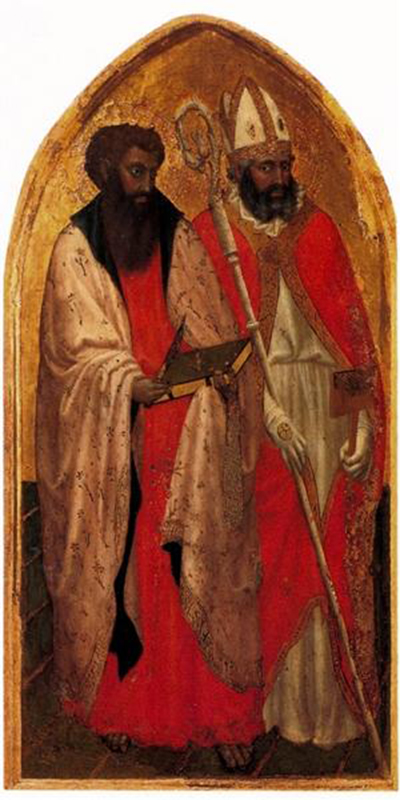The Italian Renaissance artist Masaccio was commissioned by a Family in San Giovenale known as the Florentine Family to create three prominent paintings as the altarpiece of the church.
The artist carried previous experience depicting these captivating scenes as he was commissioned to paint murals within chapels all over Italy. His amazing technique to capture biblical characters and holy entities earned him the opportunities to paint these incredible scenes.
The central altarpiece of church was San Giovenale Triptych Central Panel, yet San Giovenale Triptych Left Panel, was located right next to it and added to the story.
The two saints that are depicted within the left panel are St. Bartholomew, and St. Blaise. The significance of this panel is it showcases a modern painting technique that had not been recently touched upon by other artists. The new technique is the complex perspective at which the painting is based on, from a center panel causing the artwork to become three-dimensional. Most of Masaccio's paintings at the time were solemnly two dimensional, so the new technique shows the growth of Masaccio on his way to become a brilliant artist.
St. Bartholomew was one of JesusÕs twelve apostles, where as St. Blaise was a medical doctor who healed the poor. Both of these religious figures did a great ordeal for their community gaining them the recognition to become Saints.
As the two figures stand near one another, one holds a book with gold pages, with their other hand holding a gold feather. The other Saint holds a large religious pole that showcases their hierarchy within the church. Together their dominant presence adds to one another as they look at each other.
The figure in the left is dressed in a deep red textile, covered in a silk golden cape hanging down his shoulders. Masaccio used long deep brush strokes to illustrate the caverns and folds within the cape, which hugs his body. The Saint to the right of him wears matching attire however his is opposite to him. His undershirt is of the same creamy gold colour as his colleagues cape, however his cape is a deep red colour.
As the colour schemes between the two Saints match, their clothing creates unity within the piece as only a selected array of tones are used. The Saint to the right is accessorized in a pointed white hat covered in a mosaic swirl of gold detail, resembling the headwear of the Viking era.
Both of the figures are portrayed with deep Roman features as their olive skin tone is hidden by their thick dark brown facial hair. Their long beards flow downwards covering their necks and adding age to their character. A sense of wisdom is upraised through the artwork as their graceful age showcases knowledge and dedication.
Since the artwork is a mural to be displayed as an altarpiece; Masaccio kept his classic background colour of gold to accentuate the affluence of the painting. The colours of the gold material transitions from light to dark as the aphasic shades of bronze grasp the canvas.




